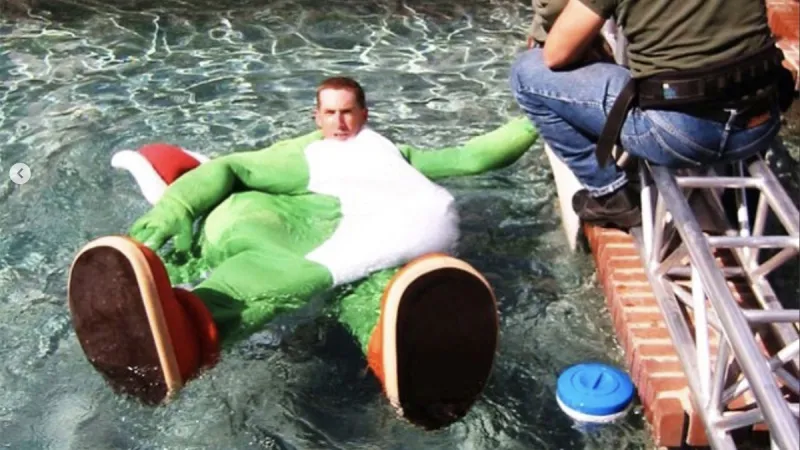

Our extra-large special edition is here. Subscribe today and receive the 25% longer issue at no extra cost!
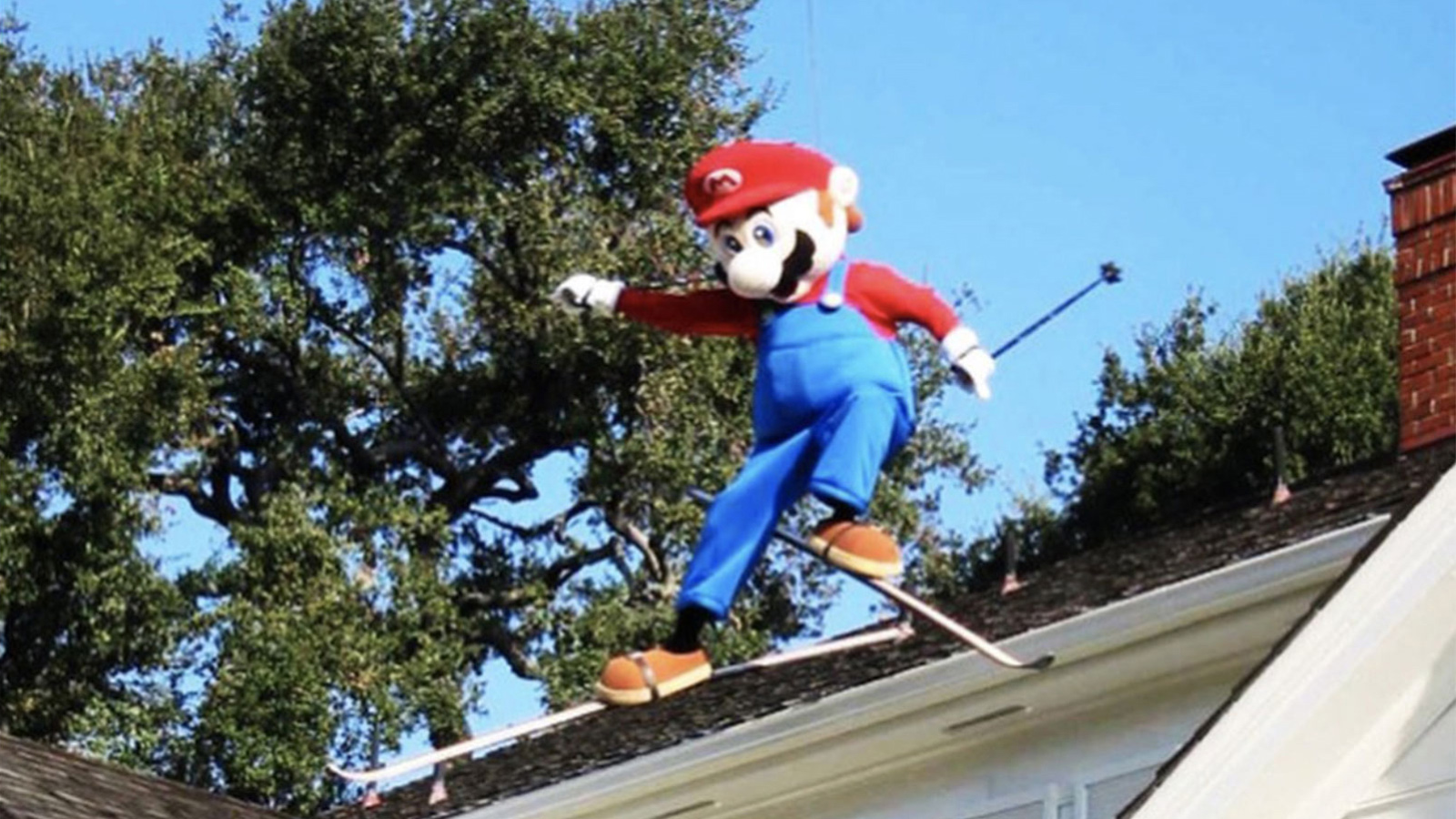

“I was raising my hand as if to say, ‘I’m about to die; someone save me,’” Tim “Fireball” Lawrence says. He was about to drown in a swimming pool. While wearing a Yoshi costume, no less.

“The head was vacuum-formed, but Yoshi’s whole body was solid foam,” adds Kathy Lawrence, the costume designer responsible for creating the mascots for dozens of Nintendo’s TV spots in the ʼ90s and 2000s.
“It went from a costume that weighed about 35 pounds to over 200 pounds,” Fireball says. “The foam, like a sponge, just absorbed the water, and I just started to sink.” Mistaking his outreached hand for a thumbs up, Kathy and the crew were excited as they watched her husband fight for his life underwater.
Fireball never trained to be a stuntman. Heʼs an illustrator, supporting Kathy’s costume business, KCL Productions, since they were both laid off from Disney in the ʼ90s. For over a decade, the couple traveled the world designing mascots for Nintendo’s commercials, including Super Smash Bros., Animal Crossing, Banjo-Tooie, Kirby, and several Mario spin-offs. Kathy crafted all the costumes while Fireball quietly donned her creations, acting in almost every commercial they worked on.
“I can think of a lot worse ways to go, I suppose,” Fireball says while chuckling, reflecting on what it’d be like to die on the set of a Mario Party 4 commercial. At the time, he claims he was more concerned with ruining a million-dollar television spot than his well-being.
“Now [I’m] freaking out because we donʼt know if we can get the water out by the next day to do the shoot,” he continues. “All these people are flying from all over the planet to come here to do their job. And weʼre not going to hold that up. And the one thing you learn by working in the film industry is that you donʼt have anyone tell you that youʼll never work in this town again; you just create that situation for yourself by something not working when you come to set.”
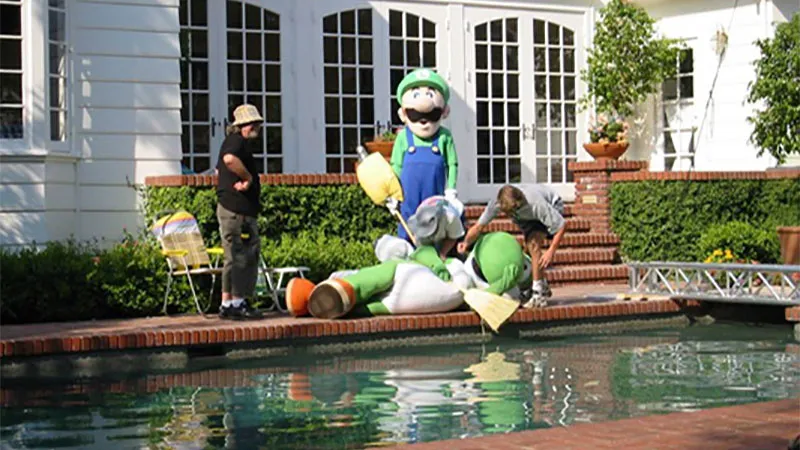
Safety was a primary concern for the crew, but the danger was a natural part of the business. In the same commercial, a stuntman flew off a roof on skis dressed as Mario. “You just make it work,” Kathy says.
According to the Lawrences, they used mascots in ways no one had ever done. The two helped one of the most successful video game companies reach a new generation of kids, now comprising a large portion of the company’s fanbase two decades later. And they did it quietly from their backyard in Santa Monica, California.

A few years after establishing their company, an ad agency called Leo Burnett Worldwide approached Kathy and Fireball to work on the very first Super Smash Bros. commercial. Set to The Turtles’ “Happy Together,” the promotional video mashes up N64 gameplay clips with footage of mascots – Mario, Yoshi, Donkey Kong, and Pikachu – beating the hell out of each other on a grassy field.
A large film crew, led by director Mark Story [Saturday Night Live Season 11], completed the half-day shoot at Walt Disney Studios’ ranch in California. While the production was far less intensive than later commercials that the Lawrences worked on, it was their first time working with Nintendo, which, according to the couple, was very strict about how its characters were portrayed.
“I say this with a fair amount of confidence: Kathy has built hundreds, if not thousands, of mascots since the early ʼ70s, and one of the most difficult costumes – if not the most difficult – was Pikachu,” Fireball says. “Itʼs hard because youʼre taking the ergonomics of a character thatʼs an inch tall, like Mario, and then youʼre trying to fit a human inside this character. And they were extremely strict, but at the same time, also very understanding that the mascots were meant to be farcical and funny, matching the flavor of the game.”
Kathy designed Pikachu to fit actress Cindy Sorenson [Star Trek: The Next Generation], who was roughly 3 feet tall, while a 7-foot-tall man wore the Donkey Kong suit. “That little lightning bolt on her back had to be perfect. ‘No, no. I think you should move it down an eighth of an inch,’” Kathy yells, imitating one of the producers they worked with.

Despite the chaos, the two describe Nintendo and Leo Burnett Worldwide as “amazingly talented, creative, and professional to work with.” Super Smash Bros. began a long, fruitful partnership between the parties.
KCL Productions shuffled through several actors to find folks comfortable with mascot acting. Most caused problems or delays on set, citing claustrophobia, heat, and asthma attacks as hindrances.
“After the Super Smash Bros. commercial, I realized I needed people to try the costumes I designed, so I asked Fireball to try them on,” Kathy says. “And because of that, he was so good at knowing how far a costume could go and how to make it alive. So, in the rest of the commercials, he was always Super Mario and Yoshi.”
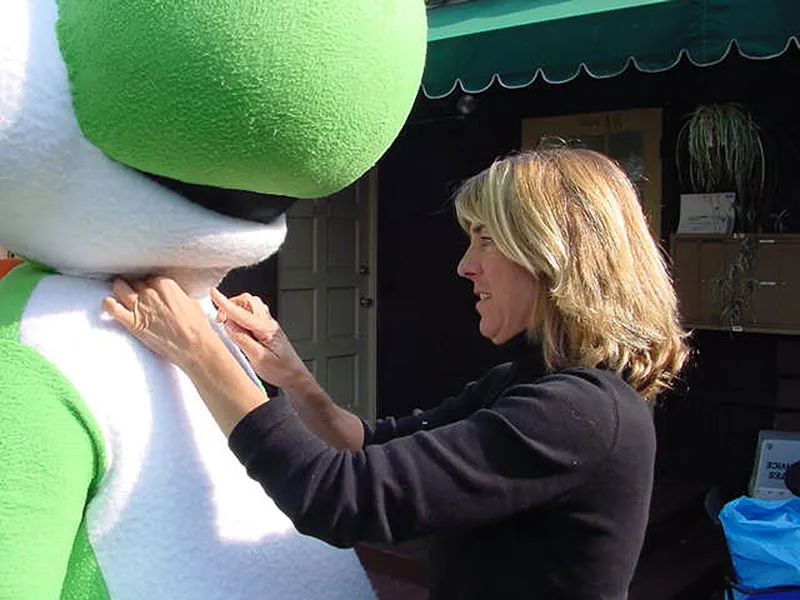
“I just knew that if I wore the costume, not only do we get paid more, which was a plus, but weʼre not going to have any problems because Iʼm not going to complain,” Fireball says.
For years, due to his contract with Nintendo, he couldn’t tell anyone he was Super Mario and Yoshi in Nintendo’s commercials. When filming near the public, his contract prohibited him from removing the mask – something he could only do behind closed doors. Following the success of the Super Smash Bros. shoot, KCL Productions followed Nintendo worldwide, filming on cruise ships in Greece, soundstages across the United States and Canada, and on the beaches of St. Thomas.
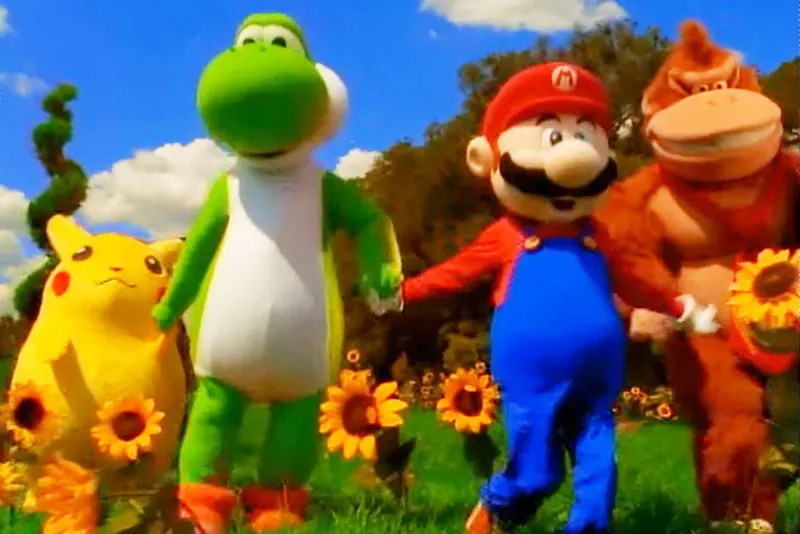
“We shot one commercial in the Virgin Islands, and it was an interesting experience with Kathy, my wife, and her ex-husband, Bob, who was acting as Luigi,” Fireball says about working on “Mario Vacation,” the codename of a 2001 Super Mario Advance 2 ad. “Bob and I ran down the beach together like best buddies dressed as Super Mario and Luigi. We get along great, and we all have a son together, but it was a surreal experience to be running down the beach in the Virgin Islands as these characters. It afforded us some unique experiences.”
Though it featured Yoshi running alongside wildlife in a safari-like setting, which the crew filmed on a horse treadmill in Hollywood, the commercial focused mainly on the swimming mechanics in Super Mario Advance 2 – the Super Mario World port on Game Boy Advance. The director, Graham Henman [Anthony Bourdain’s Bone in the Throat], decided to film with an underwater camera to replicate the game’s water levels. Kathy built two Mario mascots to accommodate the production, designing a standard one and another for filming beneath the Caribbean waves.
“We had to build a Super Mario mascot with bulged cheeks that [looked like it] could hold its breath underwater,” Fireball says. “I had to get down in the water, put the head on, put my mouth around a straw that we built into the costume’s face, blow bubbles out of it, and then pull the head off to come up and get air. It was pretty hairy just to get that one shot right.”

However, when submerged in water in pre-production, Kathy and Fireball discovered an unforeseen problem with the Mario costume. A material often found in boogie boards, L200 EVA foam, comprised several of the suit’s body parts, so Fireball’s positive buoyancy prevented him from swimming underwater. “We added dive weights to the head and feet to create zero buoyancy, allowing me to swim underwater and blow bubbles out of the mouthpiece without fighting the head and feet that wanted to surface,” Fireball says.
“There were a lot of firsts, and it was exciting to be a part of them because it was a combination of excitement and terrifying fear,” he continues. “You know that you may not make it through the shoot and that this may be your last day on earth. No one had ever really put a mascot in a swimming pool and had them swim before. Or in the ocean. I donʼt think anyone up until Banjo-Tooie had ever considered jumping out of an airplane at 12,000 feet while wearing a mascot. Thatʼs just not something that anyone had ever done before.”
“Iʼve worked for a lot of costume companies. And I can say nobody had ever done these things,” Kathy confirms.

If there was one thing Kathy was terrified of on the set of Nintendo’s Banjo-Tooie taping, it was breaking someoneʼs neck.
The premise of the ad’s story was to cheekily showcase what would happen if Banjo tried flying but forgot his bird partner, Kazooie, and it concluded with the protagonist crashing into the earth. Effectively, they were creating a live-action cartoon scene. The Lawrences built two versions of the Banjo Kazooie costume: one for a person skydiving from a moving plane and the other for a six-story crane to drop with a 200-pound dummy inside. Kathy was worried the weight of the foam head could paralyze the stuntman if something went wrong.
“I said, ‘You tell me what you need: holes in the head or whatever,’” Kathy says. “The guyʼs like, ‘No problem.’ So he did a couple of jumps out of the airplane first with the costume on but only holding the head.” The designer integrated all of the standard skydiving equipment into the piece, including a special helmet, so the performer was dressed appropriately in case of an emergency.

Back on the ground, the crew’s first unit had successfully dropped the dummy Banjo from the sky and was busy digging a hole into the dirt that fit the bear character’s snout. However, the problem was that the impact shattered the insides of the mascot’s head. Notably, Fireball still had to get inside for the last shot of a face-down Banjo raising its hand with a thumbs-up. “Weʼve thrown it over the side so many times there are all these sharp shards broken in the face,” Fireball says, adding that spiders had also crawled into the mask while lying on the ground.
Despite how unpleasant that description sounds, Fireball remembers Nintendo understanding that the mascots were the commercial’s stars, and because of that, the company treated the couple “like gold.”

Despite the danger, wild stunts, and long days, the Lawrences view their decade with Nintendo as creatively rewarding. They describe their collaborators and clients as only being professional and generous to their family-run business. Notably, fans still enjoy the publisher’s memorable commercials to this day. The Super Smash Bros. commercial is nearing 5,000,000 views since a copy was first uploaded to YouTube in 2008 by user PSNDarkKnight01.
“Kathy is a good example of someone that didnʼt question whether anything was possible,” Fireball says.
“Our son is a sculptor in the movie industry,” Kathy says. “He worked on Black Panther, and heʼs working on Star Wars right now. I told him, ‘When you have a difficult or dangerous situation, or when you have to pour in so many hours [at work] – those are going to be your stories.’ You don’t want life just to be ho-hum, you know? So now heʼs picking up the torch.”
“We were very grateful to be able to participate,” she continues. “And now thereʼs such a love for these traditional costumes. Weʼve had so many people reach out to us about our commercials and say, ‘Hey, you should do those commercials again!’ Itʼd be great, but you know, you canʼt really bring back the ʼ90s.”
This article originally appeared in Issue 356 of Game Informer.

Explore your favorite games in premium print format, delivered to your door.